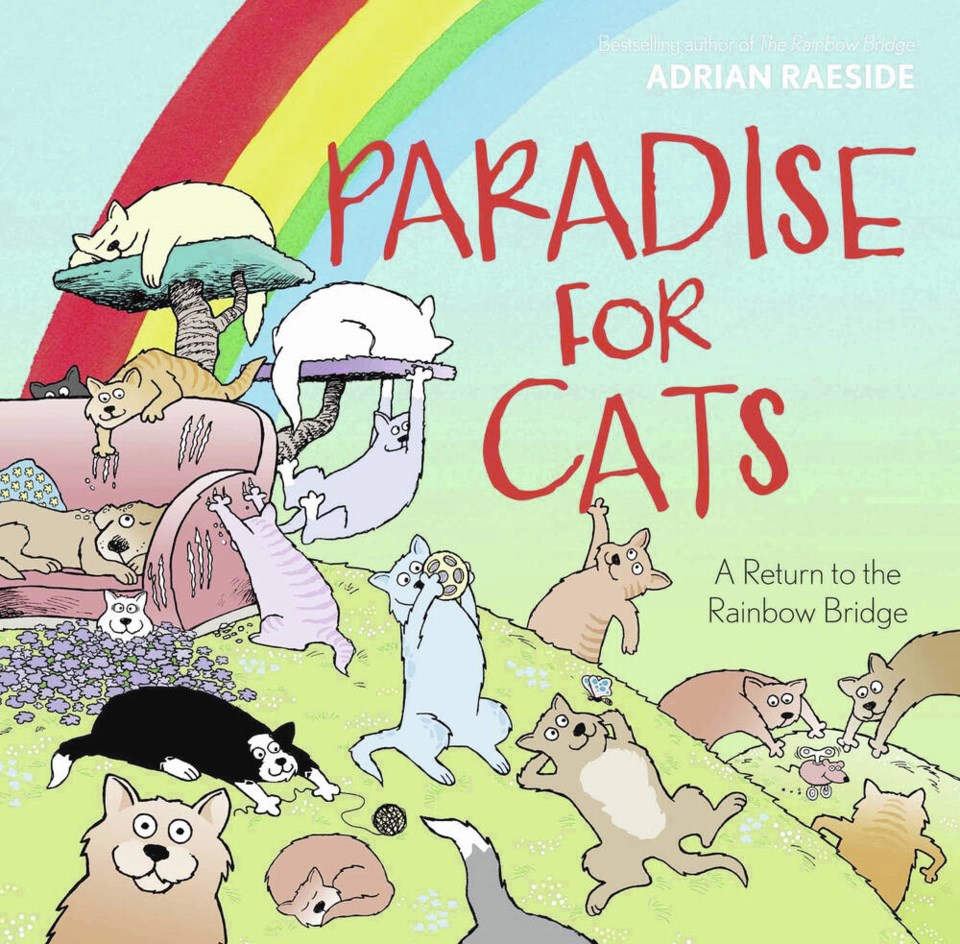Paradise for Cats: A Return to the Rainbow Bridge
By Adrian Raeside
Harbour, 40 pages, $19.95
Reviewed by Dave Obee
Amy was six years old when her best friend, a cat named Rocky, went to the Rainbow Bridge. Understandably, she was devastated.
Help came late one night when a talking dog named Buster came to Amy’s bedroom and tried to take Rocky’s squeaky mouse toy. Why? Because Rocky wanted it.
At the Rainbow Bridge, as Buster explained, cats were not allowed to catch mice.
The Rainbow Bridge? What’s that?
It is a place where pets of all kinds wait until they can be reunited with their human companions.
Before long, Amy and Buster were on their way for a visit with Rocky and a peek at what is in store for cats, dogs, mice, birds — pets of all kinds, basically — at the Rainbow Bridge.
Amy was lucky, getting a guided tour of that special place, a place every pet-loving child (and a few adults, come to think of it) needs to keep in mind as their pets age.
Thanks to Amy, Adrian Raeside takes us there as well in his book A Visit to Cat Paradise: A Return to the Rainbow Bridge.
It is a companion to 2012 book The Rainbow Bridge: A Visit to Pet Paradise, which Raeside wrote and illustrated after the loss of Koko, his dog.
“Since that book came out, I have had many letters from readers wondering if I would do a more cat-centric version,” says Raeside, the Times Colonist’s editorial cartoonist.
“Initially I resisted, as my concern was doing something that was too similar to the first book.
“But Harbour Publishing was firmly behind a cat version and, on when I thought about it, cats really are so different from dogs, so there was a lot of ‘cat material’ to work with.”
The concept is the same in the cat version as it was in the dog one. Raeside wrote and illustrated these books to comfort those who have lost their beloved pets.
The way Raeside sees it, the cat area of Rainbow Bridge is a place where cats can happily do what they like best: sleep, climb curtains, tease dogs, knock ornaments off Christmas trees, stare at birds, and so on.
Raeside grew up in New Zealand, where he spent a lot of time around farms and farm animals.
His mother, who was a children’s book author and playwright, had a big heart for any animal or bird that needed rescuing, and she wrote stories about them to read to him.
Perhaps his mother inspired the talking animals in Raeside’s Other Coast strip and books. As he says, he is fascinated by animals and likes drawing them.
“They are complex creatures with likes and dislikes and each one has their own personality,” he says.
Raeside’s interest in animals goes beyond household pets. He is working on a book about a group of forest animals who build a secret railroad in the woods.
That book might appeal to railway buffs as well as animal lovers, and who knows? It might even become a best-seller. The Rainbow Bridge had a slow start when it was released, but it became a top seller in both saąúĽĘ´«Ă˝ and the United States.
That was a surprise to publishers, who thought that a book about the death of a pet should not appear in the children’s section of a bookstore. They were wrong; it could be argued that there is a great need there, as children certainly feel the pain of a pet’s death.
The response to The Rainbow Bridge certainly proves that there is demand.
Raeside admits to knowing the loss that is felt when a beloved cat dies.
Many years ago, he rescued a kitten he found wandering at the old Oak Bay Beach Hotel.
“Nobody claimed her, so I took her home and named her ‘Snug’ after the bar at the hotel.
“She was a great little cat but sadly, one day, she disappeared. I spent ages wandering Oak Bay with her squeaky mouse, but I never saw her again.”
Snug helped inspire Rocky, in Paradise for Cats, as well as Rocky’s squeaky mouse toy.
Odds are, Paradise for Cats will prove as popular as The Rainbow Bridge, especially with parents of young children who have aging pets. Better be prepared, you might say.
But it is also relevant for adults — anyone who has ever loved and lost a pet.
Paradise for Cats is light reading, but has a strong message, one that comes from Raeside’s firm commitment to the concept of the Rainbow Bridge.
“Is there a Rainbow Bridge where pets go when they pass away?” he asks.
“The bond between us and our pets is too strong to be broken by their passing, so I do believe they are at the Rainbow Bridge, waiting.”
Dave Obee is the editor and publisher of the saąúĽĘ´«Ă˝.



